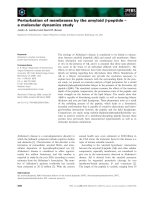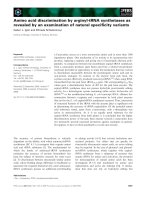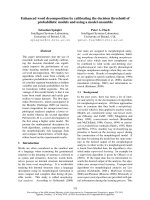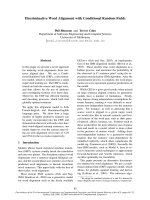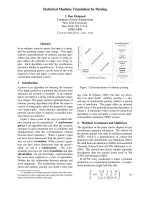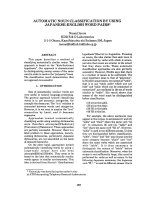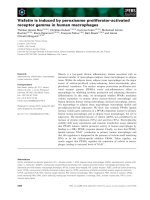Báo cáo khoa học: "Gappy Phrasal Alignment by Agreement" ppt
Bạn đang xem bản rút gọn của tài liệu. Xem và tải ngay bản đầy đủ của tài liệu tại đây (271.45 KB, 10 trang )
Proceedings of the 49th Annual Meeting of the Association for Computational Linguistics, pages 1308–1317,
Portland, Oregon, June 19-24, 2011.
c
2011 Association for Computational Linguistics
Gappy Phrasal Alignment by Agreement
Mohit Bansal
∗
UC Berkeley, CS Division
Chris Quirk
Microsoft Research
Robert C. Moore
Google Research
Abstract
We propose a principled and efficient phrase-
to-phrase alignment model, useful in machine
translation as well as other related natural lan-
guage processing problems. In a hidden semi-
Markov model, word-to-phrase and phrase-
to-word translations are modeled directly by
the system. Agreement between two direc-
tional models encourages the selection of par-
simonious phrasal alignments, avoiding the
overfitting commonly encountered in unsu-
pervised training with multi-word units. Ex-
panding the state space to include “gappy
phrases” (such as French ne pas) makes the
alignment space more symmetric; thus, it al-
lows agreement between discontinuous align-
ments. The resulting system shows substantial
improvements in both alignment quality and
translation quality over word-based Hidden
Markov Models, while maintaining asymptot-
ically equivalent runtime.
1 Introduction
Word alignment is an important part of statisti-
cal machine translation (MT) pipelines. Phrase
tables containing pairs of source and target lan-
guage phrases are extracted from word alignments,
forming the core of phrase-based statistical ma-
chine translation systems (Koehn et al., 2003).
Most syntactic machine translation systems extract
synchronous context-free grammars (SCFGs) from
aligned syntactic fragments (Galley et al., 2004;
Zollmann et al., 2006), which in turn are de-
rived from bilingual word alignments and syntactic
∗
Author was a summer intern at Microsoft Research during
this project.
French
English
voudrais voyager par chemin de fer
would like traveling by railroad
ne pas
not
Figure 1: French-English pair with complex word alignment.
parses. Alignment is also used in various other NLP
problems such as entailment, paraphrasing, question
answering, summarization and spelling correction.
A limitation to word-based alignment is undesir-
able. As seen in the French-English example in Fig-
ure 1, many sentence pairs are naturally aligned with
multi-word units in both languages (chemin de fer;
would like, where indicates a gap). Much work
has addressed this problem: generative models for
direct phrasal alignment (Marcu and Wong, 2002),
heuristic word-alignment combinations (Koehn et
al., 2003; Och and Ney, 2003), models with pseudo-
word collocations (Lambert and Banchs, 2006; Ma
et al., 2007; Duan et al., 2010), synchronous gram-
mar based approaches (Wu, 1997), etc. Most have a
large state-space, using constraints and approxima-
tions for efficient inference.
We present a new phrasal alignment model based
on the hidden Markov framework (Vogel et al.,
1996). Our approach is semi-Markov: each state can
generate multiple observations, representing word-
to-phrase alignments. We also augment the state
space to include contiguous sequences. This cor-
responds to phrase-to-word and phrase-to-phrase
alignments. We generalize alignment by agreement
(Liang et al., 2006) to this space, and find that agree-
ment discourages EM from overfitting. Finally, we
make the alignment space more symmetric by in-
cluding gappy (or non-contiguous) phrases. This al-
lows agreement to reinforce non-contiguous align-
1308
f
1
f
2
f
3
e
1
e
2
e
3
f
1
f
2
f
3
e
1
e
2
e
3
Observations→
?
?
States→
HMM(E|F) HMM(F|E)
Figure 2: The model of E given F can represent the phrasal
alignment {e
1
, e
2
} ∼ {f
1
}. However, the model of F given
E cannot: the probability mass is distributed between {e
1
} ∼
{f
1
} and {e
2
} ∼ {f
1
}. Agreement of the forward and back-
ward HMM alignments tends to place less mass on phrasal links
and greater mass on word-to-word links.
ments, such English not to French ne pas. Prun-
ing the set of allowed phrases preserves the time
complexity of the word-to-word HMM alignment
model.
1.1 Related Work
Our first major influence is that of conditional
phrase-based models. An early approach by Deng
and Byrne (2005) changed the parameterization of
the traditional word-based HMM model, modeling
subsequent words from the same state using a bi-
gram model. However, this model changes only the
parameterization and not the set of possible align-
ments. More closely related are the approaches
of Daum
´
e III and Marcu (2004) and DeNero et
al. (2006), which allow phrase-to-phrase alignments
between the source and target domain. As DeN-
ero warns, though, an unconstrained model may
overfit using unusual segmentations. Interestingly,
the phrase-based hidden semi-Markov model of
Andr
´
es-Ferrer and Juan (2009) does not seem to
encounter these problems. We suspect two main
causes: first, the model interpolates with Model 1
(Brown et al., 1994), which may help prevent over-
fitting, and second, the model is monotonic, which
screens out many possible alignments. Monotonic-
ity is generally undesirable, though: almost all par-
allel sentences exhibit some reordering phenomena,
even when languages are syntactically very similar.
The second major inspiration is alignment by
agreement by Liang et al. (2006). Here, soft inter-
section between the forward (F→E) and backward
(E→F) alignments during parameter estimation pro-
duces better word-to-word correspondences. This
unsupervised approach produced alignments with
incredibly low error rates on French-English, though
only moderate gains in end-to-end machine transla-
tion results. Likely this is because the symmetric
portion of the HMM space contains only single word
to single word links. As shown in Figure 2, in order
to retain the phrasal link f
1
∼ e
1
, e
2
after agree-
ment, we need the reverse phrasal link e
1
, e
2
f
1
in the backward direction. However, this is not pos-
sible in a word-based HMM where each observa-
tion must be generated by a single state. Agreement
tends to encourage 1-to-1 alignments with very high
precision and but lower recall. As each word align-
ment acts as a constraint on phrase extraction, the
phrase-pairs obtained from those alignments have
high recall and low precision.
2 Gappy Phrasal Alignment
Our goal is to unify phrasal alignment and align-
ment by agreement. We use a phrasal hidden semi-
Markov alignment model, but without the mono-
tonicity requirement of Andr
´
es-Ferrer and Juan
(2009). Since phrases may be used in both the state
and observation space of both sentences, agreement
during EM training no longer penalizes phrasal links
such as those in Figure 2. Moreover, the benefits of
agreement are preserved: meaningful phrasal links
that are likely in both directions of alignment will be
reinforced, while phrasal links likely in only one di-
rection will be discouraged. This avoids segmenta-
tion problems encountered by DeNero et al. (2006).
Non-contiguous sequences of words present an
additional challenge. Even a semi-Markov model
with phrases can represent the alignment between
English not and French ne pas in one direction
only. To make the model more symmetric, we ex-
tend the state space to include gappy phrases as
well.
1
The set of alignments in each model becomes
symmetric, though the two directions model gappy
phrases differently. Consider not and ne pas:
when predicting French given English, the align-
ment corresponds to generating multiple distinct ob-
1
We only allow a single gap with one word on each end.
This is sufficient for the vast majority of the gapped phenomena
that we have seen in our training data.
1309
voudrais
voyager
par
chemin
de
fer
would
like
traveling
by
railroad
C
would
like
traveling
by
railroad
voudrais
voyager
par
chemin
de
fer
not
pas
ne
not
ne
pas
Observations→
States→
Observations→
States→
Figure 3: Example English-given-French and French-given-English alignments of the same sentence pair using the Hidden Semi-
Markov Model (HSMM) for gapped-phrase-to-phrase alignment. It allows the state side phrases (denoted by vertical blocks),
observation side phrases (denoted by horizontal blocks), and state-side gaps (denoted by discontinuous blocks in the same column
connected by a hollow vertical “bridge”). Note both directions can capture the desired alignment for this sentence pair.
servations from the same state; in the other direction,
the word not is generated by a single gappy phrase
ne pas. Computing posteriors for agreement is
somewhat complicated, so we resort to an approx-
imation described later. Exact inference retains a
low-order polynomial runtime; we use pruning to in-
crease speed.
2.1 Hidden Markov Alignment Models
Our model can be seen as an extension of the stan-
dard word-based Hidden Markov Model (HMM)
used in alignment (Vogel et al., 1996). To
ground the discussion, we first review the struc-
ture of that model. This generative model has
the form p(O|S) =
A
p(A, O|S), where S =
(s
1
, . . . , s
I
) ∈ Σ
is a sequence of words from a
vocabulary Σ; O = (o
1
, . . . , o
J
) ∈ Π
is a sequence
from vocabulary Π; and A = (a
1
, . . . , a
J
) is the
alignment between the two sequences. Since some
words are systematically inserted during translation,
the target (state) word sequence is augmented with
a special NULL word. To retain the position of the
last aligned word, the state space contains I copies
of the NULL word, one for each position (Och and
Ney, 2003). The alignment uses positive positions
for words and negative positions for NULL states, so
a
j
∈ {1 I} ∪ {−1 − I}, and s
i
= NULL if i < 0.
It uses the following generative procedure. First
the length of the observation sequence is selected
based on p
l
(J|I). Then for each observation posi-
tion, the state is selected based on the prior state: a
null state with probability p
0
, or a non-null state at
position a
j
with probability (1 − p
0
) · p
j
(a
j
|a
j−1
)
where p
j
is a jump distribution. Finally the observa-
tion word o
j
at that position is generated with prob-
ability p
t
(o
j
|s
a
j
), where p
t
is an emission distribu-
tion:
p(A, O|S) = p
l
(J|I)
J
j=1
p
j
(a
j
|a
j−1
)p
t
(o
j
|s
a
j
)
p
j
(a|a
) =
(1 − p
0
) · p
d
(a − |a
|) a > 0
p
0
· δ(|a|, |a
|) a < 0
We pick p
0
using grid search on the development
set, p
l
is uniform, and the p
j
and p
t
are optimized by
EM.
2
2.2 Gappy Semi-Markov Models
The HMM alignment model identifies a word-
to-word correspondence between the observation
2
Note that jump distances beyond -10 or 10 share a single
parameter to prevent sparsity.
1310
words and the state words. We make two changes
to expand this model. First, we allow contiguous
phrases on the observation side, which makes the
model semi-Markov: at each time stamp, the model
may emit more than one observation word. Next, we
also allow contiguous and gappy phrases on the state
side, leading to an alignment model that can retain
phrasal links after agreement (see Section 4).
The S and O random variables are unchanged.
Since a single state may generate multiple observa-
tion words, we add a new variable K representing
the number of states. K should be less than J, the
number of observations. The alignment variable is
augmented to allow contiguous and non-contiguous
ranges of words. We allow only a single gap, but of
unlimited length. The null state is still present, and
is again represented by negative numbers.
A =(a
1
, . . . , a
K
) ∈ A(I)
A(I) ={(i
1
, i
2
, g)|0 < i
1
≤ i
2
≤ I,
g ∈ {GAP, CONTIG}}∪
{(−i, −i, CONTIG) | 0 < i ≤ I}
We add one more random variable to capture the to-
tal number of observations generated by each state.
L ∈ {(l
0
, l
1
, . . . , l
K
) | 0 = l
0
< · · · < l
K
= J}
The generative model takes the following form:
p(A, L, O|S) =p
l
(J|I)p
f
(K|J)
K
k=1
p
j
(a
k
|a
k−1
)·
p
t
(l
k
, o
l
k
l
k−1
+1
|S[a
k
], l
k−1
)
First, the length of the observation sequence (J)
is selected, based on the number of words in the
state-side sentence (I). Since it does not affect the
alignment, p
l
is modeled as a uniform distribution.
Next, we pick the total number of states to use (K),
which must be less than the number of observations
(J). Short state sequences receive an exponential
penalty: p
f
(K|J) ∝ η
(J−K)
if 0 ≤ K ≤ J, or 0
otherwise. A harsh penalty (small positive value of
η) may prevent the systematic overuse of phrases.
3
3
We found that this penalty was crucial to prevent overfitting
in independent training. Joint training with agreement made it
basically unnecessary.
Next we decide the assignment of each state.
We retain the first-order Markov assumption: the
selection of each state is conditioned only on the
prior state. The transition distribution is identical
to the word-based HMM for single word states. For
phrasal and gappy states, we jump into the first word
of that state, and out of the last word of that state,
and then pay a cost according to how many words
are covered within that state. If a = (i
1
, i
2
, g), then
the beginning word of a is F (a) = i
1
, the end-
ing word is L(a) = i
2
, and the length N (a) is 2
for gapped states, 0 for null states, and last(a) −
first(a) + 1 for all others. The transition probabil-
ity is:
p
j
(a|a
) =
p
0
· δ(|F (a)|, |L(a
)|) if F (a) < 0
(1 − p
0
)p
d
(F (a) − |L(a
)|)·
p
n
(N(a)) otherwise
where p
n
(c) ∝ κ
c
is an exponential distribution. As
in the word HMM case, we use a mixture parameter
p
0
to determine the likelihood of landing in a NULL
state. The position of that NULL state remembers the
last position of the prior state. For non-null words,
we pick the first word of the state according to the
distance from the last word of the prior state. Finally,
we pick a length for that final state according to an
exponential distribution: values of κ less than one
will penalize the use of phrasal states.
For each set of state words, we maintain an emis-
sion distribution over observation word sequences.
Let S[a] be the set of state words referred to by
the alignment variable a. For example, the English
given French alignment of Figure 3 includes the fol-
lowing state word sets:
S[(2, 2, CONTIG)] = voudrais
S[(1, 3, GAP)] = ne pas
S[(6, 8, CONTIG)] = chemin de fer
For the emission distribution we keep a multinomial
over observation phrases for each set of state words:
p(l, o
l
l
|S[a], l
) ∝ c(o
l
l
|S[a])
In contrast to the approach of Deng and Byrne
(2005), this encourages greater consistency across
instances, and more closely resembles the com-
monly used phrasal translation models.
1311
We note in passing that p
f
(K|J) may be moved
inside the product: p
f
(K|J) ∝ η
(J−K)
=
K
k=1
η
(l
k
−l
k−1
−1)
. The following form derived us-
ing the above rearrangement is helpful during EM.
p(A, L, O|S) ∝
K
k=1
p
j
(a
k
|a
k−1
)·
p
t
(l
k
, o
l
k
l
k−1
+1
|S[a
k
], l
k−1
)·
η
(l
k
−l
k−1
−1)
where l
k
− l
k−1
− 1 is the length of the observation
phrase emitted by state S[a
k
].
2.3 Minimality
At alignment time we focus on finding the minimal
phrase pairs, under the assumption that composed
phrase pairs can be extracted in terms of these min-
imal pairs. We are rather strict about this, allowing
only 1 → k and k → 1 phrasal alignment edges
(or links). This should not cause undue stress, since
edges of the form 2 − 3 (say e
1
e
2
∼ f
1
f
2
f
3
) can
generally be decomposed into 1 − 1 ∪ 1 − 2 (i.e.,
e
1
∼ f
1
∪ e
2
∼ f
2
f
3
), etc. However, the model
does not require this to be true: we will describe re-
estimation for unconstrained general models, but use
the limited form for word alignment.
3 Parameter Estimation
We use Expectation-Maximization (EM) to estimate
parameters. The forward-backward algorithm effi-
ciently computes posteriors of transitions and emis-
sions in the word-based HMM. In a standard HMM,
emission always advances the observation position
by one, and the next transition is unaffected by
the emission. Neither of these assumptions hold
in our model: multiple observations may be emit-
ted at a time, and a state may cover multiple state-
side words, which affects the outgoing transition. A
modified dynamic program computes posteriors for
this generalized model.
The following formulation of the forward-
backward algorithm for word-to-word alignment is
a good starting point. α[x, 0, y] indicates the total
mass of paths that have just transitioned into state y
at observation x but have not yet emitted; α[x, 1, y]
represents the mass after emission but before subse-
quent transition. β is defined similarly. (We omit
NULL states for brevity; the extension is straightfor-
ward.)
α[0, 0, y] = p
j
(y|INIT)
α[x, 1, y] = α[x, 0, y] · p
t
(o
x
|s
y
)
α[x, 0, y] =
y
α[x − 1, 1, y
] · p
j
(y|y
)
β[n, 1, y] = 1
β[x, 0, y] = p
t
(o
x
|s
y
) · β[x, 1, y]
β[x, 1, y] =
y
p
j
(y
|y) · β[x + 1, 0, y
]
Not only is it easy to compute posteriors of both
emissions (α[x, 0, y]p
t
(o
x
|s
y
)β[x, 1, y]) and transi-
tions (α[x, 1, y]p
j
(y
|y)β[x + 1, 0, y
]) with this for-
mulation, it also simplifies the generalization to
complex emissions. We update the emission forward
probabilities to include a search over the possible
starting points in the state and observation space:
α[0, 0, y] =p
j
(y|INIT)
α[x, 1, y] =
x
<x,y
≤y
α[x
, 0, y
] · EMIT(x
: x, y
: y)
α[x, 0, y] =
y
α[x − 1, 1, y
] · p
j
(y|y
)
β[n, 1, y] =1
β[x
, 0, y
] =
x
<x,y
≤y
EMIT(x
: x, y
: y) · β[x, 1, y]
β[x, 1, y] =
y
p
j
(y
|y) · β[x + 1, 0, y
]
Phrasal and gapped emissions are pooled into EMIT:
EMIT(w : x, y : z) =p
t
(o
x
w
|s
z
y
) · η
z−y+1
· κ
x−w+1
+
p
t
(o
x
w
|s
y
s
z
) · η
2
· κ
x−w+1
The transition posterior is the same as above. The
emission is very similar: the posterior probability
that o
x
w
is aligned to s
z
y
is proportional to α[w, 0, y] ·
p
t
(o
x
w
|s
z
y
)·η
z−y+1
·κ
x−w+1
·β[x, 1, z]. For a gapped
phrase, the posterior is proportional to α[w, 0, y] ·
p
t
(o
x
w
|s
y
s
z
) · η
2
· κ
x−w+1
· β[x, 1, z].
Given an inference procedure for computing pos-
teriors, unsupervised training with EM follows im-
mediately. We use a simple maximum-likelihood
update of the parameters using expected counts
based on the posterior distribution.
1312
4 Alignment by Agreement
Following Liang et al. (2006), we quantify agree-
ment between two models as the probability that the
alignments produced by the two models agree on the
alignment z of a sentence pair x = (S, O):
z
p
1
(z|x; θ
1
)p
2
(z|x; θ
2
)
To couple the two models, the (log) probability of
agreement is added to the standard log-likelihood
objective:
max
θ
1
,θ
2
x
log p
1
(x; θ
1
) + log p
2
(x; θ
2
)+
log
z
p
1
(z|x; θ
1
)p
2
(z|x; θ
2
)
We use the heuristic estimator from Liang et al.
(2006), letting q be a product of marginals:
E : q(z; x) :=
z∈z
p
1
(z|x; θ
1
)p
2
(z|x; θ
2
)
where each p
k
(z|x; θ
k
) is the posterior marginal of
some edge z according to each model. Such a
heuristic E step computes the marginals for each
model separately, then multiplies the marginals cor-
responding to the same edge. This product of
marginals acts as the approximation to the posterior
used in the M step for each model. The intuition is
that if the two models disagree on a certain edge z,
then the marginal product is small, hence that edge
is dis-preferred in each model.
Contiguous phrase agreement. It is simple to
extend agreement to alignments in the absence of
gaps. Multi-word (phrasal) links are assigned some
posterior probability in both models, as shown in the
example in Figure 3, and we multiply the posteriors
of these phrasal links just as in the single word case.
4
γ
F →E
(f
i
, e
j
) := γ
E→F
(e
j
, f
i
)
:= [γ
F →E
(f
i
, e
j
) × γ
E→F
(e
j
, f
i
)]
4
Phrasal correspondences can be represented in multiple
ways: multiple adjacent words could be generated from the
same state either using one semi-Markov emission, or using
multiple single word emissions followed by self-jumps. Only
the first case is reinforced through agreement, so the latter is
implicitly discouraged. We explored an option to forbid same-
state transitions, but found it made little difference in practice.
Gappy phrase agreement. When we introduce
gappy phrasal states, agreement becomes more chal-
lenging. In the forward direction F→E, if we have a
gappy state aligned to an observation, say f
i
f
j
∼
e
k
, then its corresponding edge in the backward di-
rection E→F would be e
k
f
i
f
j
. How-
ever, this is represented by two distinct and unre-
lated emissions. Although it is possible the compute
the posterior probability of two non-adjacent emis-
sions, this requires running a separate dynamic pro-
gram for each such combination to sum the mass be-
tween these emissions. For the sake of efficiency
we resort to an approximate computation of pos-
terior marginals using the two word-to-word edges
e
k
f
i
and e
k
f
j
.
The forward posterior γ
F →E
for edge f
i
f
j
∼
e
k
is multiplied with the min of the backward pos-
teriors of the edges e
k
f
i
and e
k
f
j
.
γ
F →E
(f
i
f
j
, e
k
) := γ
F →E
(f
i
f
j
, e
k
)×
min
γ
E→F
(e
k
, f
i
), γ
E→F
(e
k
, f
j
)
Note that this min is an upper bound on the desired
posterior of edge e
k
f
i
f
j
, since every path
that passes through e
k
f
i
and e
k
f
j
must pass
through e
k
f
i
, therefore the posterior of e
k
f
i
f
j
is less than that of e
k
f
i
, and likewise less
than that of e
k
f
j
.
The backward posteriors of the edges e
k
f
i
and
e
k
f
j
are also mixed with the forward posteriors
of the edges to which they correspond.
γ
E→F
(e
k
, f
i
) := γ
E→F
(e
k
, f
i
) ×
γ
F →E
(f
i
, e
k
)+
h<i<j
γ
F →E
(f
h
f
i
, e
k
) + γ
F →E
(f
i
f
j
, e
k
)
5 Pruned Lists of ‘Allowed’ Phrases
To identify contiguous and gapped phrases that are
more likely to lead to good alignments, we use word-
to-word HMM alignments from the full training data
in both directions (F→E and E→F). We collect ob-
servation phrases of length 2 to K aligned to a single
state, i.e. o
j
i
∼ s, to add to a list of allowed phrases.
For gappy phrases, we find all non-consecutive ob-
servation pairs o
i
and o
j
such that: (a) both are
1313
aligned to the same state s
k
, (b) state s
k
is aligned to
only these two observations, and (c) at least one ob-
servation between o
i
and o
j
is aligned to a non-null
state other than s
k
. These observation phrases are
collected from F→E and E→F models to build con-
tiguous and gappy phrase lists for both languages.
Next, we order the phrases in each contiguous list
using the discounted probability:
p
δ
(o
j
i
∼ s|o
j
i
) =
max(0, count(o
j
i
∼ s) − δ)
count(o
j
i
)
where count(o
j
i
∼ s) is the count of occurrence of
the observation-phrase o
j
i
, all aligned to some sin-
gle state s, and count(o
j
i
) is the count of occur-
rence of the observation phrase o
j
i
, not all necessar-
ily aligned to a single state. Similarly, we rank the
gappy phrases using the discounted probability:
p
δ
(o
i
o
j
∼ s|o
i
o
j
) =
max(0, count(o
i
o
j
∼ s) − δ)
count(o
i
o
j
)
where count(o
i
o
j
∼ s) is the count of occur-
rence of the observations o
i
and o
j
aligned to a sin-
gle state s with the conditions mentioned above, and
count(o
i
o
j
) is the count of general occurrence of
the observations o
i
and o
j
in order. We find that 200
gappy phrases and 1000 contiguous phrases works
well, based on tuning with a development set.
6 Complexity Analysis
Let m be the length of the state sentence S and n
be the length of the observation sentence O. In IBM
Model 1 (Brown et al., 1994), with only a translation
model, we can infer posteriors or max alignments
in O(mn). HMM-based word-to-word alignment
model (Vogel et al., 1996) adds a distortion model,
increasing the complexity to O(m
2
n).
Introducing phrases (contiguous) on the observa-
tion side, we get a HSMM (Hidden Semi-Markov
Model). If we allow phrases of length no greater
than K, then the number of observation types
rises from n to Kn for an overall complexity of
O(m
2
Kn). Introducing state phrases (contiguous)
with length ≤ K grows the number of state types
from m to Km. Complexity further increases to
O((Km)
2
Kn) = O(K
3
m
2
n).
Finally, when we introduce gappy state phrases of
the type s
i
s
j
, the number of such phrases is
O(m
2
), since we may choose a start and end point
independently. Thus, the total complexity rises to
O((Km + m
2
)
2
Kn) = O(Km
4
n). Although this
is less than the O(n
6
) complexity of exact ITG (In-
version Transduction Grammar) model (Wu, 1997),
a quintic algorithm is often quite slow.
The pruned lists of allowed phrases limit this
complexity. The model is allowed to use observa-
tion (contiguous) and state (contiguous and gappy)
phrases only from these lists. The number of
phrases that match any given sentence pair from
these pruned lists is very small (∼ 2 to 5). If the
number of phrases in the lists that match the obser-
vation and state side of a given sentence pair are
small constants, the complexity remains O(m
2
n),
equal to that of word-based models.
7 Results
We evaluate our models based on both word align-
ment and end-to-end translation with two language
pairs: English-French and English-German. For
French-English, we use the Hansards NAACL 2003
shared-task dataset, which contains nearly 1.1 mil-
lion training sentence pairs. We also evaluated
on German-English Europarl data from WMT2010,
with nearly 1.6 million training sentence pairs. The
model from Liang et al. (2006) is our word-based
baseline.
7.1 Training Regimen
Our training regimen begins with both the forward
(F→E) and backward (E→F) iterations of Model 1
run independently (i.e. without agreement). Next,
we train several iterations of the forward and back-
ward word-to-word HMMs, again with independent
training. We do not use agreement during word
alignment since it tends to produce sparse 1-1 align-
ments, which in turn leads to low phrase emission
probabilities in the gappy model.
Initializing the emission probabilities of the semi-
Markov model is somewhat complicated, since the
word-based models do not assign any mass to
the phrasal or gapped configurations. Therefore
we use a heuristic method. We first retrieve the
Viterbi alignments of the forward and backward
1314
word-to-word HMM aligners. For phrasal corre-
spondences, we combine these forward and back-
ward Viterbi alignments using a common heuris-
tic (Union, Intersection, Refined, or Grow-Diag-
Final), and extract tight phrase-pairs (no unaligned
words on the boundary) from this alignment set.
We found that Grow-Diag-Final was most effective
in our experiments. The counts gathered from this
phrase extraction are used to initialize phrasal trans-
lation probabilities. For gappy states in a forward
(F→E) model, we use alignments from the back-
ward (E→F) model. If a state s
k
is aligned to two
non-consecutive observations o
i
and o
j
such that s
k
is not aligned to any other observation, and at least
one observation between o
i
and o
j
is aligned to a
non-null state other than s
k
, then we reverse this
link to get o
i
o
j
∼ s
k
and use it as a gapped-
state-phrase instance for adding fractional counts.
Given these approximate fractional counts, we per-
form a standard MLE M-step to initialize the emis-
sion probability distributions. The distortion proba-
bilities from the word-based model are used without
changes.
7.2 Alignment Results (F1)
The validation and test sentences have been hand-
aligned (see Och and Ney (2003)) and are marked
with both sure and possible alignments. For French-
English, following Liang et al. (2006), we lowercase
all words, and use the validation set plus the first
100 test sentences as our development set and the
remaining 347 test-sentences as our test-set for fi-
nal F1 evaluation.
5
In German-English, we have a
development set of 102 sentences, and a test set of
258 sentences, also annotated with a set of sure and
possible alignments. Given a predicted alignment A,
precision and recall are computed using sure align-
ments S and possible alignments P (where S ⊆ P )
as in Och and Ney (2003):
P recision =
|A ∩ P |
|A|
× 100%
Recall =
|A ∩ S|
|S|
× 100%
5
We report F1 rather than AER because AER appears not to
correlate well with translation quality.(Fraser and Marcu, 2007)
Language pair Word-to-word Gappy
French-English 34.0 34.5
German-English 19.3 19.8
Table 2: BLEU results on German-English and French-English.
AER =
1 −
|A ∩ S| + |A ∩ P |
|A| + |S|
× 100%
F
1
=
2 × P recision × Recall
P recision + Recall
× 100%
Many free parameters were tuned to optimize
alignment F1 on the development set, including the
number of iterations of each Model 1, HMM, and
Gappy; the NULL weight p
0
, the number of con-
tiguous and gappy phrases to include, and the max-
imum phrase length. Five iterations of all models,
p
0
= 0.3, using the top 1000 contiguous phrases
and the top 200 gappy phrases, maximum phrase
length of 5, and penalties η = κ = 1 produced
competitive results. Note that by setting η and κ to
one, we have effectively removed the penalty alto-
gether without affecting our results. In Table 1 we
see a consistent improvement with the addition of
contiguous phrases, and some additional gains with
gappy phrases.
7.3 Translation Results (BLEU)
We assembled a phrase-based system from the align-
ments (using only contiguous phrases consistent
with the potentially gappy alignment), with 4 chan-
nel models, word and phrase count features, dis-
tortion penalty, lexicalized reordering model, and a
5-gram language model, weighted by MERT. The
same free parameters from above were tuned to opti-
mize development set BLEU using grid search. The
improvements in Table 2 are encouraging, especially
as a syntax-based or non-contiguous phrasal system
(Galley and Manning, 2010) may benefit more from
gappy phrases.
8 Conclusions and Future Work
We have described an algorithm for efficient unsu-
pervised alignment of phrases. Relatively straight-
forward extensions to the base HMM allow for ef-
ficient inference, and agreement between the two
1315
Data Decoding method Word-to-word +Contig phrases +Gappy phrases
FE 10K Viterbi 89.7 90.6 90.3
FE 10K Posterior ≥ 0.1 90.1 90.4 90.7
FE 100K Viterbi 93.0 93.6 93.8
FE 100K Posterior ≥ 0.1 93.1 93.7 93.8
FE All Viterbi 94.1 94.3 94.3
FE All Posterior ≥ 0.1 94.2 94.4 94.5
GE 10K Viterbi 76.2 79.6 79.7
GE 10K Posterior ≥ 0.1 76.7 79.3 79.3
GE 100K Viterbi 81.0 83.0 83.2
GE 100K Posterior ≥ 0.1 80.7 83.1 83.4
GE All Viterbi 83.0 85.2 85.6
GE All Posterior ≥ 0.1 83.7 85.3 85.7
Table 1: F1 scores of automatic word alignments, evaluated on the test set of the hand-aligned sentence pairs.
models prevents EM from overfitting, even in the ab-
sence of harsh penalties. We also allow gappy (non-
contiguous) phrases on the state side, which makes
agreement more successful but agreement needs ap-
proximation of posterior marginals. Using pruned
lists of good phrases, we maintain complexity equal
to the baseline word-to-word model.
There are several steps forward from this point.
Limiting the gap length also prevents combinato-
rial explosion; we hope to explore this in future
work. Clearly a translation system that uses discon-
tinuous mappings at runtime (Chiang, 2007; Gal-
ley and Manning, 2010) may make better use of
discontinuous alignments. This model can also be
applied at the morpheme or character level, allow-
ing joint inference of segmentation and alignment.
Furthermore the state space could be expanded and
enhanced to include more possibilities: states with
multiple gaps might be useful for alignment in lan-
guages with template morphology, such as Arabic or
Hebrew. More exploration in the model space could
be useful – a better distortion model might place a
stronger distribution on the likely starting and end-
ing points of phrases.
Acknowledgments
We would like to thank the anonymous reviewers for
their helpful suggestions. This project is funded by
Microsoft Research.
References
Jes
´
us Andr
´
es-Ferrer and Alfons Juan. 2009. A phrase-
based hidden semi-Markov approach to machine trans-
lation. In Proceedings of EAMT.
Peter F. Brown, Stephen A. Della Pietra, Vincent J. Della
Pietra, and Robert L. Mercer. 1994. The mathematics
of statistical machine translation: Parameter estima-
tion. Computational Linguistics, 19:263–311.
David Chiang. 2007. Hierarchical phrase-based transla-
tion. Computational Linguistics.
Hal Daum
´
e III and Daniel Marcu. 2004. A phrase-based
HMM approach to document/abstract alignment. In
Proceedings of EMNLP.
John DeNero, Dan Gillick, James Zhang, and Dan Klein.
2006. Why generative phrase models underperform
surface heuristics. In Proceedings of ACL.
Yonggang Deng and William Byrne. 2005. HMM word
and phrase alignment for statistical machine transla-
tion. In Proceedings of HLT-EMNLP.
Xiangyu Duan, Min Zhang, and Haizhou Li. 2010.
Pseudo-word for phrase-based machine translation. In
Proceedings of ACL.
Alexander Fraser and Daniel Marcu. 2007. Measuring
word alignment quality for statistical machine transla-
tion. Computational Linguistics, 33(3):293–303.
Michel Galley and Christopher D. Manning. 2010. Ac-
curate non-hierarchical phrase-based translation. In
HLT/NAACL.
Michel Galley, Mark Hopkins, Kevin Knight, and Daniel
Marcu. 2004. What’s in a translation rule? In Pro-
ceedings of HLT-NAACL.
Philipp Koehn, Franz Och, and Daniel Marcu. 2003. Sta-
tistical Phrase-Based Translation. In Proceedings of
HLT-NAACL.
Patrik Lambert and Rafael Banchs. 2006. Grouping
multi-word expressions according to part-of-speech in
1316
statistical machine translation. In Proc. of the EACL
Workshop on Multi-Word-Expressions in a Multilin-
gual Context.
Percy Liang, Ben Taskar, and Dan Klein. 2006. Align-
ment by agreement. In Proceedings of HLT-NAACL.
Yanjun Ma, Nicolas Stroppa, and Andy Way. 2007.
Boostrapping word alignment via word packing. In
Proceedings of ACL.
Daniel Marcu and Daniel Wong. 2002. A phrase-based,
joint probability model for statistical machine transla-
tion. In Proceedings of EMNLP.
Franz Josef Och and Hermann Ney. 2003. A system-
atic comparison of various statistical alignment mod-
els. Computational Linguistics, 29:19–51.
Stephan Vogel, Hermann Ney, and Christoph Tillmann.
1996. HMM-based word alignment in statistical trans-
lation. In Proceedings of COLING.
Dekai Wu. 1997. Stochastic inversion transduction
grammars and bilingual parsing of parallel corpora.
Computational Linguistics, 23:377–404.
Andreas Zollmann, Ashish Venugopal, and Stephan Vo-
gel. 2006. Syntax augmented machine translation via
chart parsing. In Processings of the Statistical Ma-
chine Translation Workshop at NAACL.
1317

